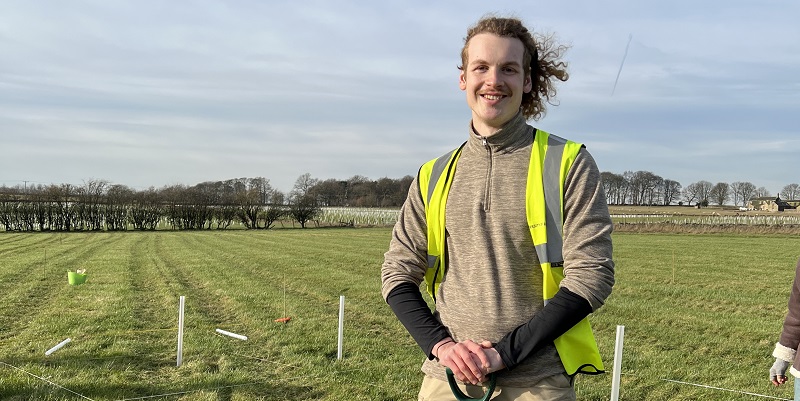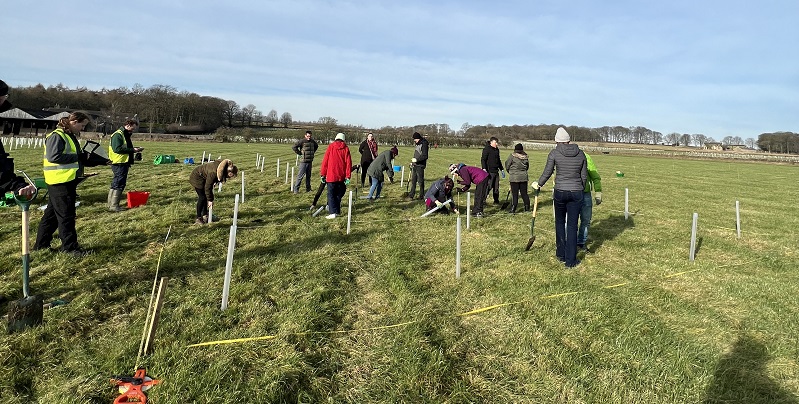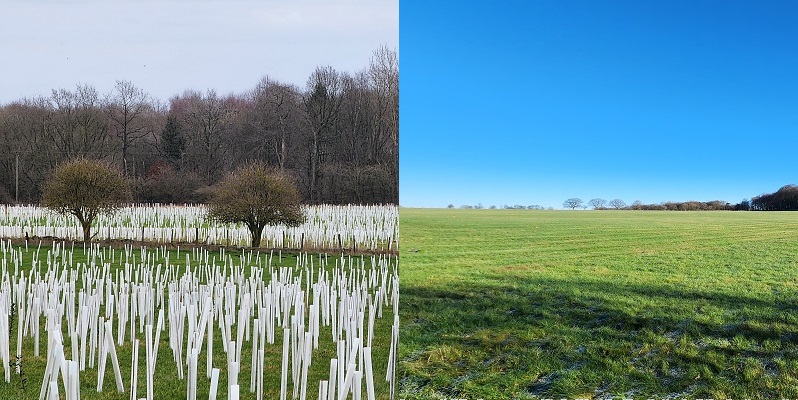Looking back and ahead at Gair Wood

I’m Sam, one of the Student Sustainability Architects for the Gair Wood forestry project. I’ve been helping to run volunteer tree-planting sessions on site and to make sure the project is engaging for students, staff and the local community.
The awakening of dormant trees with Spring marks the end of the planting season. Over the last couple of months, a sea of saplings has rolled over the Gair Wood site as part of planting efforts to create 15 hectares of new woodland and another five hectares of scrub. It’s been striking to watch over time as more and more tree guards pop up on the grass – and even more rewarding to watch volunteers’ eyes light up as they stepped onsite and realised just how big the project is.
With each tree planted this future forest felt more real and now more than 60,000 new seedlings are in the ground ready for their time in the sun.
Two intense months getting to know Gair Wood
Working on a site like Gair Wood so intensively for six weeks forces you to pay attention to the details and changes over time, however big or slight. I started my time there with freezing clear mornings and ended it in a downpour. The hedge up the drive was bare and quiet in mid-January; by early March it had buds and birdsong. Everywhere felt more alive the more I paid attention: abundant red kites gliding sentinel overhead, hares bounding about between the tree guards, worms peeking out from the holes I dug. Even the sheep on the farm next door seemed to get louder, bleating constantly as if to say: “Get a move on!”
After all, change is so much of what makes Gair Wood such an important place.
The more time I spent onsite, the more I saw how Gair Wood fostered community and connections. Dedicated groups of strangers came together for sessions - many on cold weekday mornings, some even on Saturdays - and were soon chatting away, helped along simply by the act of planting trees. Everyone was constantly brimming with enthusiasm and optimism, quickly learning the simple-but-critical art of planting a sapling, and the more difficult task of pronouncing “pedunculate oak”.

Leaving Gair Wood after the final volunteer session hit me harder than I thought it would - especially considering we’d been planting in the rain and spent our lunch break hunkered in the barn sat on bags of bamboo canes.
But it’s hard not to feel connected to somewhere that you’ve spent so long working at - especially when you’ve worked with a team so determined to make Gair Wood happen.
Looking ahead
As they should, the environmental benefits of the Gair Wood pique most people’s interest. As the new woodland grows, the site’s 36 hectares should transform from mostly grassland into a mosaic of different habitats. More habitats mean more homes for more species. Biodiversity, hopefully, will blossom.
As a living laboratory, researchers will collect and benefit from the data gathered onsite for years to come, helping us understand how the density of tree planting and the diversity of species planted affects all manner of ecosystem phenomena.
But I like to think Gair Wood’s future doesn’t just lie in the sciences. The community’s involvement in creating Gair Wood is crucial, because the site will ultimately become a community asset. When the saplings have grown enough to support themselves - a few years at least - the land will be opened to the public via footpaths linked to neighbouring Golden Acre Park. People will be able to enjoy a new green space that previously wasn’t available, and those who planted trees will be able to point out with pride the saplings they set on their journey (though they might need a very good memory). I know I’ll be among them.
Going forward I’d like to see what ideas those in the local and University community have for other uses of the site. Whether you’d like to explore the possibilities for photography, field recordings or mindfulness, feel free to email me at s.b.brooke@leeds.ac.uk to talk about your ideas.

Keep up to date on the latest news
-
-
- Follow us on Twitter: @UoL_Sus
- Follow us on Instagram: @uol_sus
- Follow us on Facebook: @UoLSustainability
- Sign up to our Sustainability newsletter
-
United Nations Sustainable Development Goals
 We use the United Nations Sustainable Development Goals (SDGs) as a framework to guide our activity. Our work on Student Citizenship links to all of the SDGs.
We use the United Nations Sustainable Development Goals (SDGs) as a framework to guide our activity. Our work on Student Citizenship links to all of the SDGs.
Find out more about our impact on the SDGs.
